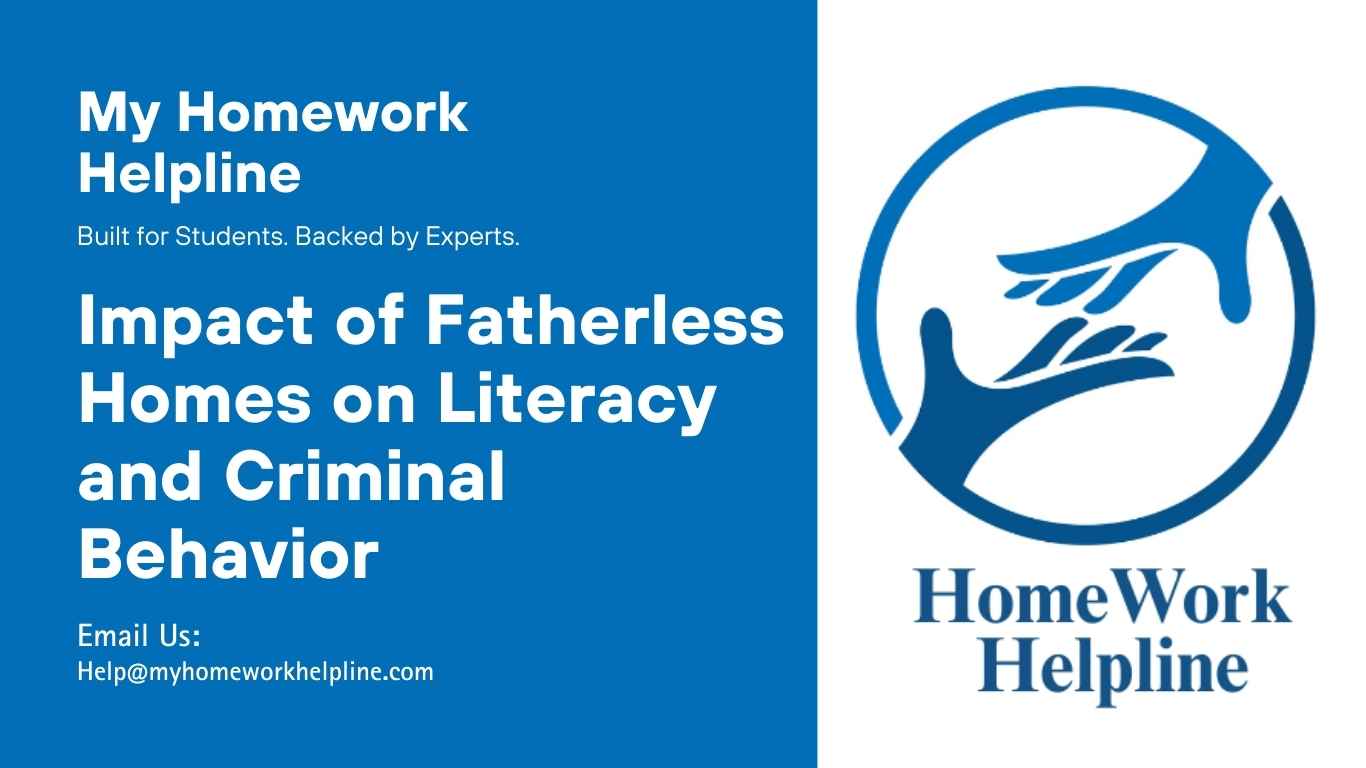Fatherless Homes, Illiteracy Rates, and Criminal Behavior Research Paper
A father’s absence at home influences children’s cognitive and behavioral development directly or indirectly. The direct influence relates to family structure breakdown, with the father’s absence associated with social stigma, lack of social control, and indiscipline (Harkness et al., 2019). Conversely, the indirect impacts of paternal absence relate to socio-economic theories that link children’s outcomes to mediating variables such as parental economic disparities or the impact of family instability on social stress. The implications of family structure on children’s outcomes center around resources and family type – single parent or otherwise. Fathers’ absence at home is associated with disruptions such as home or school relocations that may adversely affect children’s development. Moreover, fatherless homes have more observable differences in mothers’ education or age than families that don’t separate. Such differences may directly or indirectly affect literacy outcomes and influence criminal behavior.
Need expert guidance on writing your criminal justice assignment? At My Homework Helpline, we provide professional criminal justice homework assistance to help you tackle essays, research papers, and case studies. Get personalized support to ensure your work is thoroughly researched, properly structured, and delivered on time, giving you the confidence to achieve top grades in your coursework and excel in your criminal justice studies.
Fatherless Homes and Illiteracy Rates
Fatherless homes are associated with undesirable childhood outcomes relating to literacy and cognitive attainment. For instance, single-mother families are typically at a higher risk of poverty and reduced income (Lu et al., 2019). These disadvantages are predictors of low cognitive attainment. High income empowers parents to invest more in children’s academic development or literacy. Stack and Meredith (2017) found that single-parent families have a disproportionately higher risk of financial hardship. Their findings suggest that fatherless homes are likely to have lower incomes, reducing children’s access to educational resources such as books and toys or a conducive learning environment. Income challenges in fatherless homes may also limit participation in educational activities such as school trips or projects. Another adverse effect of paternal absence relates to parental stress, modulating child well-being, parent-child relationships, and parenting styles. Father absence is a crude proxy for child literacy determinants. It affects the quality of their nurturing environment, modulating the influence of poverty, low income, and family structure on children’s cognitive attainment or literacy.
Fatherless Homes and Criminal Behavior.
Criminological theories suggest a positive correlation between paternal absence and adolescent criminal behavior. An increase in the likelihood of juvenile delinquency in the absence of a conventional figure is consistent with the social bond theory in criminology (Hoffmann & Dufur, 2018). Weak weal parent-child relationships translate to weak bonds, leading to adverse delinquency outcomes. Alternatively, strong bonds enhance adolescents’ commitment to meeting parents’ expectations and prevents engagement in criminal behavior. Since two parents are naturally better equipped to cultivate positive child behavior than single parents, paternal absence may result in child behavioral problems that mothers may be unable to resolve. Father absence may lead to juvenile delinquency since mothers, juggling parenting and homemaking, may not have the time to provide the requisite monitoring or affection.
Paternal absence exposes youth to various risk factors leading to criminal behavior. Research suggests that youth in fatherless homes are disproportionally more likely to engage in severe delinquency and subsequent incarceration than those in intact families (Simmons et al., 2018). From the previous discussion, children in fatherless homes are more likely to be poor or have lower family incomes. The income-level disparities between two-parent and single-mother homes are a possible explanation for the association between youth incarceration and paternal absence. Fathers’ presence relieve mothers of some parenting responsibilities while providing the psychological and emotional support required to instill positive behavior in children collectively. Conversely, juggling parenting and homemaking with single mothers may predispose youth to the risks of parental indifference and hostility, leading to criminal behavior.
Father characteristics modulate the effects of father absence on child antisocial behaviors that could translate to criminal activities. Kim and Glassgow (2018) found that paternal absence affects child outcomes such as economic and educational outcomes, mental health, depression, delinquency, and aggression. However, unstable family contexts mediate the effects of paternal absence on youth behavior. For instance, conflicts related to the father’s departure may be emotionally destabilizing to children, triggering delinquent behavior. Such conflicts exacerbate child anxiety and stress leading to maladjustment. Therefore, child criminal behavior may be in response to the emotional disruptions of marital conflict. Moreover, poor economic conditions due to fathers’ absence may also foster child antisocial behavior and delinquency. This outcome is because fatherless homes are more likely to experience financial hardships that limit child life opportunities and increase the risk of antisocial or criminal behavior.
Although the preponderance of research suggests a positive correlation between father absence and criminal behavior, maternal attachment is an equally significant predictor of criminal behavior. Some studies indicate that secure attachment to the available parent can remedy the effects of paternal absence on delinquency (Simmons et al., 2018). Such results suggest that it is possible for youth in fatherless homes to develop positively. Other examinations of the link between adolescent delinquency and family stricture indicate no association between the two variables holding maternal attachment constant. These results imply maternal attachment is equally a predictor of child delinquency.
Selection into Single Motherhood and Child Outcomes
While previous research suggests a strong correlation between the factors influencing childhood outcomes and the likelihood of fatherlessness, selection bias in research may make it challenging to accurately represent the effect of fatherlessness on child outcomes. For instance, the risks enhancing the possibilities of father absence also modulate child attainment and parenting (Harkness et al., 2019). It is difficult to identify the causal factors since most of these personal traits are unmeasured. Most studies use sibling differences to account for selection bias when exploring the effects of fatherlessness on children. However, such studies use identification assumptions to compromise generalizability while emphasizing internal results’ vulnerability. For instance, fatherless homes with only one child are typically excluded from such studies. Moreover, studies on fixed effects utilize cognitive outcomes measured before parental separation, making them irrelevant in situations where separation occurs in early childhood. This approach makes correcting selection bias in studies with many fatherless homes difficult.
Conclusion
Children in fatherless homes are predisposed to direct and direct adverse outcomes on cognitive and behavioral development. Fathers’ absence weaken family structures and lower family income impairing access to education resources and a conducive learning environment. Studies indicate that fatherless homes are likely to have lower incomes, reducing children’s access to educational resources such as books and toys or a conducive learning environment. These results suggest that paternal absence negatively affects the quality of the nurturing environment disrupting cognitive attainment and increasing illiteracy rates. It also exposes youth to various risk factors leading to criminal behavior. Youth in fatherless homes are disproportionally more likely to engage in severe delinquency and subsequent incarceration than those in intact families. These adverse outcomes are related to the likelihood of poverty or low income in fatherless homes. Father’ absence may limit life opportunities, foster antisocial behavior, and enhance the likelihood of illiteracy and criminal behavior.
References
Harkness, S., Gregg, P., & Fernández‐Salgado, M. (2019). The rise in single‐mother families and children’s cognitive development: Evidence from three british birth cohorts. Child Development, 91(5). https://doi.org/10.1111/cdev.13342
Hoffmann, J. P., & Dufur, M. J. (2018). Family social capital, family social bonds, and juvenile delinquency. American Behavioral Scientist, 62(11), 1525–1544. https://doi.org/10.1177/0002764218787020
Kim, S., & Glassgow, A. E. (2018). The effect of father’s absence, parental adverse events, and neighborhood disadvantage on children’s aggression and delinquency: A multi-analytic approach. Journal of Human Behavior in the Social Environment, 28(5), 570–587. https://doi.org/10.1080/10911359.2018.1443866
Lu, Y.-C., Walker, R., Richard, P., & Younis, M. (2019). Inequalities in poverty and income between single mothers and fathers. International Journal of Environmental Research and Public Health, 17(1), 135. https://doi.org/10.3390/ijerph17010135
Simmons, C., Steinberg, L., Frick, P. J., & Cauffman, E. (2018). The differential influence of absent and harsh fathers on juvenile delinquency. Journal of Adolescence, 62, 9–17. https://doi.org/10.1016/j.adolescence.2017.10.010
Stack, R. J., & Meredith, A. (2017). The Impact of Financial Hardship on Single Parents: An Exploration of the Journey from Social Distress to Seeking Help. Journal of Family and Economic Issues, 39(2), 233–242. https://doi.org/10.1007/s10834-017-9551-6

